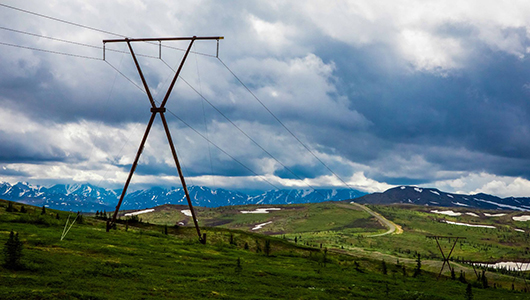The Alaska electrical power landscape includes a multi-utility transmission connected grid, the Railbelt, which stretches from Homer to Fairbanks and serves about 75% of the population; smaller transmission connected systems in the Panhandle; and approximately 200 isolated microgrids which serve remote communities ranging from tens to thousands of people.
The cost of generating power in Alaska can be very high, as can be the consequences of extended power outages. Researchers from ACEP’s Power System Integration (PSI) program collaborate with communities, utilities, industry and governmental, tribal and regional entities to increase the resilience of these power systems and reduce energy costs and emissions by maximizing the contribution from local clean energy resources.
The Power Systems Integration (PSI) program at ACEP collaborates with local, regional and national stakeholders to increase the resilience of power systems and reduce energy costs and emissions across Alaska and beyond. Through modeling and simulation, our research supports the planning, design, and operation of power systems. We use laboratory testing to validate technologies with real hardware and field deployments to demonstrate practical (and often demanding) applications of technology. As many renewable energy and energy storage technologies require power electronics, one underlying theme of the PSI program research is the bridging of power systems and power electronics disciplines to design, operate, and model high renewable contribution power systems.
PSI Research Areas
Traditionally, power system modeling has included four sets of tools — capacity expansion, production cost modeling (PCM), electromechanical dynamical (positive-sequence) modeling and electromagnetic transient (EMT) modeling — each focused on a distinct time scale. However, the proliferation of emerging technology (including variable renewable generation [VRG], distributed generation, load participation and energy storage), the increasing frequency of extreme climatic events, and new market mechanisms are requiring linkages and/or new approaches between the traditional capacity expansion, PCM and dynamical modeling tools to ensure reliability and equity across expected future scenarios. Furthermore, the proliferation of inverter-based resources (IBRs) is forcing linkages and/or new approaches between the electromechanical and the electromagnetic modeling tools to ensure stability and reliability for expected operating conditions including contingencies.
In addition to a physical transformation, the ability to measure, store and process massive amounts of digital information is creating new opportunities to leverage data analytics. Data analytics is the process of discovering, interpreting and using patterns in raw data, for the design and operation of power systems. There are four types of data analytics, each seeking to answer a different question: Descriptive (What happened?); Diagnostic (Why did it happen?); Predictive (What will happen next?); and Prescriptive (What should we do?). Power system modeling and data analytics go hand-in-hand because the models can be used to create rich data sets to develop and validate analytical algorithms.
The PSI program operates a 480 V, 500 kW scale microgrid test bed which was designed to represent an exemplary remote Alaska microgrid (embed link to PSI lab site). The PSI lab includes a diesel generator, battery energy storage system capable of grid-forming operation, PV and wind emulators, programmable load banks, an RL line length emulator, and a fault emulator. In addition, the lab includes programmable AC and DC power supplies for power electronic development and testing. Testing activities in the PSI lab include validation of equipment functionality before deploying, evaluation of microgrid control strategies, testing of prototype power electronic converters, and benchmarking of power system / power electronic dynamic models.

While laboratory testing is invaluable to validate components and functionalities, the Alaska energy landscape offers unique opportunities to deploy practical, effective, innovative, and equitable energy solutions in real-world applications where they can not only make a direct impact on local communities, but they can also serve as credible demonstrations at the national and international level. In fact, Alaska has a long history of developing renewable microgrids beginning in the late 1990’s with Kotzebue, St. Paul, and Wales. ACEP power system research focuses on finding opportunities where supporting a community to achieve their own self-determined energy goals aligns with globally relevant research and could (continue) to put the spotlight on Alaska as an innovative leader in renewable microgrid technologies. The core enabler for these efforts are relationships with community, utility, industrial, regional, and tribal energy leaders across Alaska.
PSI Project Highlights

Sep 04
This research investigates whether displacing fuel oil used for space heating with energy efficiency improvements and renewably generated electricity can substantially reduce households' energy cost burden in remote Arctic communities.

Jan 05
This project seeks to provide an independent, unbiased assessment to help inform future decisions by Alaska utilities and other stakeholders, while demonstrating the opportunities and challenges facing isolated regional electric grids seeking to decarbonize.

Jan 01
As a member of the UNIFI, or Universal Interoperability for Grid-Forming Inverter Consortium, ACEP attempts to advance grid-forming inverter technologies and to help provide new guidance for effective and stable inverter operations.
PSI Laboratory
The Power Systems Integration Laboratory or PSI Lab is located within the Energy Technology Facility (ETF) on the ÌÀÄ·ÊÓƵ campus and emulates an isolated hybrid-diesel grid at up to 500 kW of permanently installed capacity and potential capacity of several MW. Operating on the same scale as an Alaska village power system, the PSI lab has the ability to be modified for individual test scenarios and provide valuable data for researchers, communities policy makers, and industrial clients.

PSI Research Team
Interested in joining our team in Alaska?
If you have a BS, MS, and/or Ph.D in electrical engineering, and are seeking employment, graduate studies, or a postdoctoral position in power systems or power electronics, please reach out to the individual researchers on the PSI team.




